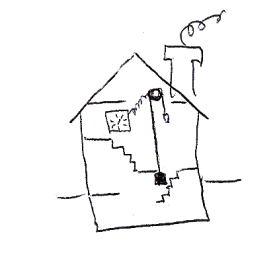Two less vital things before we proceed.
One is, that some gadgets we mentioned (e.g. the door lock) have two power sources (a primary and a plan B); the "power controller" part then gets inevitably more complex, having to handle both and switch between them as appropriate. Also, some gadgets have several functions, with different power consumption and different priorities for scheduling/permanent or intermittent powering - this is for example the clock, with timekeeping part (RTC), display and control, and radio receiver for precise time setup.

The other thing is an unrelated idea or question: having mentioned mechanical power source, what amount of energy can we talk about? Let's push things a bit to the edge: say having a 100kg weight running all the way from attic to cellar, say 10m, can it power a clock for a century?
 The total energy is , let's assume an unrealistic 100% conversion efficiency (or 50% and compensated by having the weight 200kg); that's h.m.g = cca 10kJ. As mentioned previously, an alkaline AA cell which can run the clock roughly one year contains around 3-4Wh of energy, 3600 seconds in a hour... it's just around 10kJ!
The total energy is , let's assume an unrealistic 100% conversion efficiency (or 50% and compensated by having the weight 200kg); that's h.m.g = cca 10kJ. As mentioned previously, an alkaline AA cell which can run the clock roughly one year contains around 3-4Wh of energy, 3600 seconds in a hour... it's just around 10kJ!The good old pendulum clock needed to be wound up every day, say 1kg weight up 1m, that's 10J - and given the number of days in a year it's around 3.6kJ. Turns out, the mechanical clocks were pretty well optimized per energy consumption.
 Jan Waclawek
Jan Waclawek
Discussions
Become a Hackaday.io Member
Create an account to leave a comment. Already have an account? Log In.